Outer Beauty
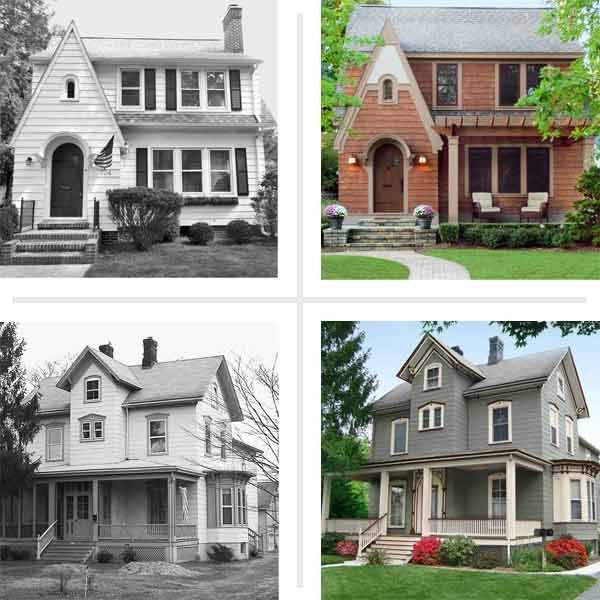
A well-designed exterior is a joy to come home to that can earn you major points with your neighbors—and attract potential buyers, down the road. This Old House readers have been hard at work fixing up their facades, and on the following pages, we share six of their impressive results with you. Whether you’re looking to make a big change (putting on a new front porch) or a small one that yields a big impact (hint: harness the power of paint), you’ll find inspiration here, along with tips for making it happen without straining your budget.
Draw Out Distinctive Details With Paint: Before
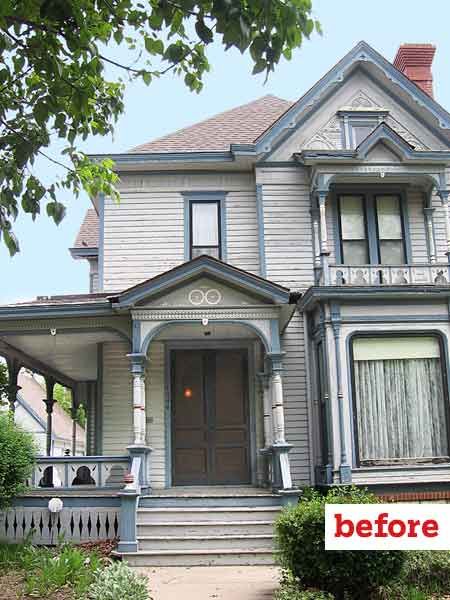
A drab color scheme camouflaged the architectural elements that defined Steve and Joann Paul’s Gothic Revival, in Wichita, Kansas. With revived woodwork and a five-color palette, the formerly tired 1886 house reclaims its proud Painted Lady heritage.
Draw Out Distinctive Details With Paint: After
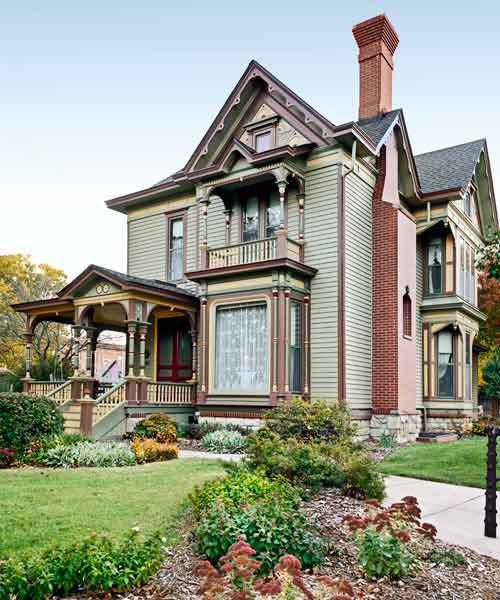
Paint: Steve and Joann tested 18 paint swatches on the house before making their final picks: Sherwin-Williams‘s Garden Sage for the base color, accented with darker-green Meadow Trail, cinnamony Tanbark, and golden White Raisin. They did the front door and some smaller details in Carriage Door.
Porch: They salvaged all but one of the old columns and posts but replaced what Joann dubbed the “Alfred Hitchcock silhouette” balustrade on the balcony and the diamond-patterned skirting, which likely weren’t original to the house, with more traditional woodwork in rot- and termite-resistant Spanish cedar.
Draw Out Distinctive Details With Paint: Porch and Entry
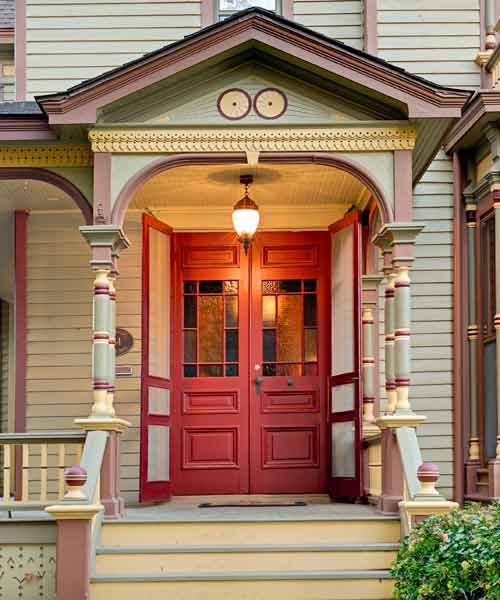
Trim: Except for a few rotted sections that were too far gone, most of the woodwork merely had to be scraped and caulked prior to painting. About 40 percent of the home’s water-damaged soffits were swapped out for new panels made of tongue-and-groove Douglas fir.
Landscaping: The couple cleaned up the overgrown gardens and supplemented what was there with shrubs and perennials that can handle the prairie climate, including Cistena plums, dwarf Japanese barberry, liriope, and heat-tolerant peonies.
Customize a Classic Style: Before
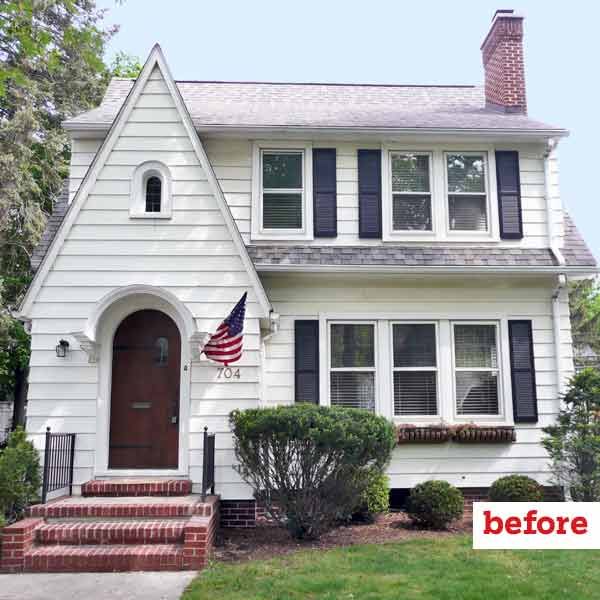
Jeff Aneiros could see that, underneath its plain-Jane front, his 1927 English-style cottage, in Birmingham, Michigan, had strong character. A car designer with a strong aesthetic sensibility, he wanted to create a facade with more visual interest. Working with his dad, Rick, who acted as general contractor, Jeff remade every inch of the exterior.
Customize a Classic Style: After
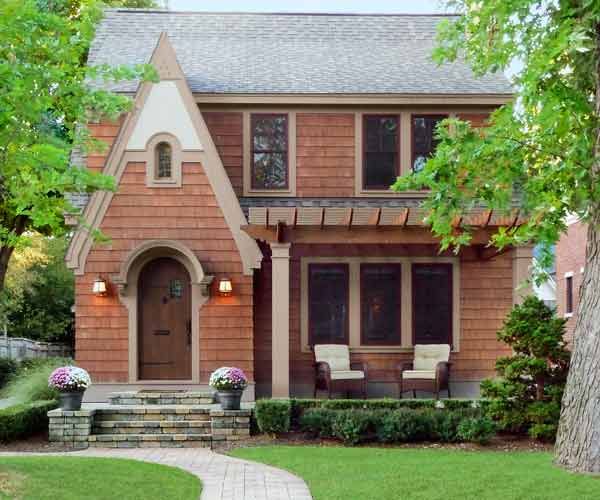
A pergola adds visual interest to the facade without blocking light.
Siding and trim: The new facade, designed by Rick, features prestained western red cedar shingles, composite stucco, and layers of composite trim painted in Sherwin-Williams‘s Spalding Gray. All the materials resist rot.
Windows and door: Single-pane windows were swapped for more efficient double-hungs with wood interiors and factory-painted red aluminum exteriors. Jeff kept the front gable’s original arched entry, a hallmark of the English-cottage style, but refinished the door with a medium-brown stain.
Customize a Classic Style: Garage
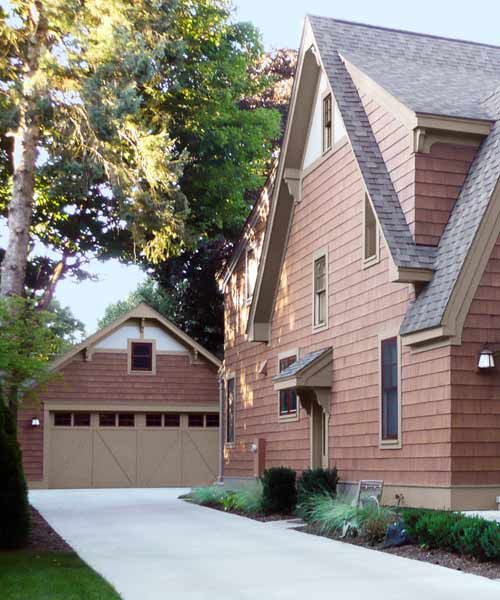
Stonework: A masonry team replaced the concrete front walkway and brick steps with Belgian-block-look pavers and carried the material through to the floor of the new pergola-topped porch. A freshly poured concrete driveway leads to the new two-car garage, which replaced one that was in disrepair.
Landscaping: Silver maple trees shade the yard for much of the morning, so Jeff filled the bed in front of the porch with shrubs that demand only partial sun: boxwoods, red barberries, and a dwarf hinoki cypress tree. A row of arborvitaes lines the driveway, providing color, a windbreak, and privacy.
Create Period Appeal: Before
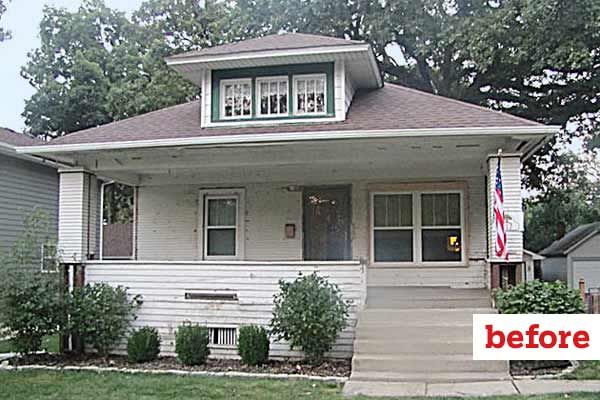
The Craftsman character of Augie and Ellyn Annoreno’s 1924 bungalow, in Bartlett, Illinois, was obscured by wide aluminum siding, a nondescript front porch, and misguided “updates,” such as a Victorian-style entry door. With some thoughtful renovations, including a new mahogany front door, the couple brought back the period charm—and earned a plaque from the local historical society.
Porch: A pair of chunky wood posts was not enough to support the roof, which bowed beneath the central dormer. With an architect and a contractor, the couple devised a new porch supported by a trio of tapered cedar columns in the Craftsman style. Augie, a former bricklayer, dug and poured the concrete footings for the columns and did the veneer work on the pier supports. He also replaced rotted floorboards with tongue-and-groove Douglas fir.
Create Period Appeal: After
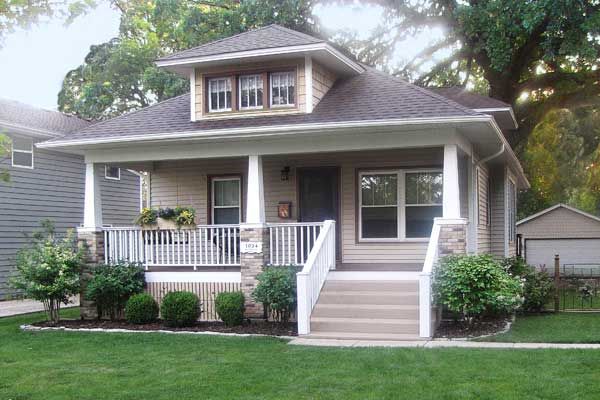
Porch skirting doesn’t have to be boring. Here, a handsome slatted pattern echoes the cedar railings.
Windows : The couple had previously replaced the home’s modern casement windows with three-over-one double-hungs that reference the triple-pane originals on the dormer.
Siding: They liked the low-maintenance aspect of the white 8-inch-reveal aluminum siding but not the look—or the dents that appeared after a hailstorm. So they upgraded to 4½-inch-reveal tan vinyl clapboards that match the scale of the original wood claps, and vinyl shakes to distinguish the dormer. Red window trim complements the brickwork.
Lighting: Recessed fixtures and an amber glass sconce with a geometric, Frank Lloyd Wright-inspired motif now illuminate the porch, a major improvement over the single pendant that used to dangle awkwardly over the doorframe.
Uncover Hidden Character: Before
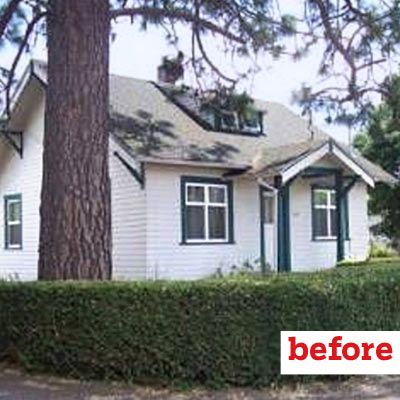
Outside, Tim and Wendy Hogan’s 1926 bungalow was drab but in relatively good shape. Even so, thanks to Oregon’s cool, wet weather, it took two and a half years to transform the exterior and the overgrown yard. With Tim, whose dad was a woodworker, handling the construction and Wendy on design, they turned the fixer-upper into a high-wattage charmer.
Paint: Wendy wanted the colors to pop, so she steered clear of neutrals and went with a custom-mixed Sherwin-Williams green for the siding and brown on the trim, then spiced up the earthy hues with a splash of Benjamin Moore‘s Caribbean Blue Water on the stoop risers and a bold citrus, similar to Behr‘s Orange Burst, on the entry door.
Uncover Hidden Character: After
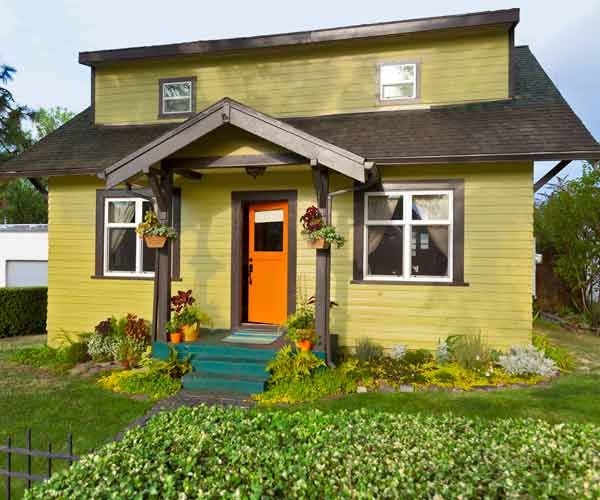
Landscaping: The first task the Hogans tackled was reining in the monster boxwoods lining the front walk to make way for an entry garden filled with colorful foliage plants and a new path that Wendy built with a pile of cobblestones discovered in the yard.
Dormers: Tim framed out full-length front and back shed dormers to gain ceiling height and floor space upstairs. To preserve the facade’s character and sense of proportion, he kept the addition relatively small and took style cues for the windows and roofline from the original dormer.
Expand The Front Porch: Before
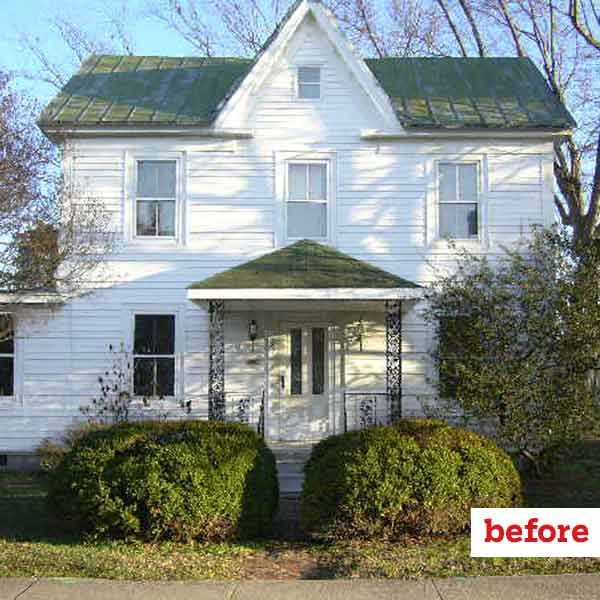
When Cheryl Smith and Skip McPherson first laid eyes on their 1885 Folk Victorian, in Reedville, Virginia, they saw a giant void where a gracious front porch had once stood. After a yearlong DIY revamp, the broad, friendly porch is back, and Cheryl and Skip’s place is one of the most visited destinations on the block.
Porch: Skip, a seasoned renovator, tore off the ill-proportioned concrete-and-wrought-iron portico and designed and built its traditional-style replacement: an 8-by-32-foot porch constructed with pressure-treated pine posts and railings, composite decking, and a plywood beadboard ceiling.
Expand The Front Porch: After
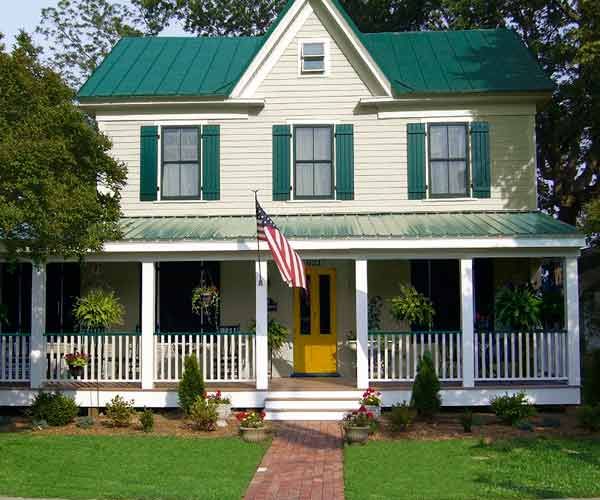
Siding and roof: They replaced the aluminum siding with fiber cement, painted Benjamin Moore’s November Rain. The new porch has a standing-seam steel roof to match the original house roof, which got a power-washing and a fresh coat of Essex Green.
Windows: The couple swapped the old windows for lookalike two-over-two double-hungs that are much more energy efficient. To cut costs, Skip crafted and installed decorative board-and-batten-style shutters made from weather- and insect-proof PVC.
Spiff Up The Existing Structure: Before
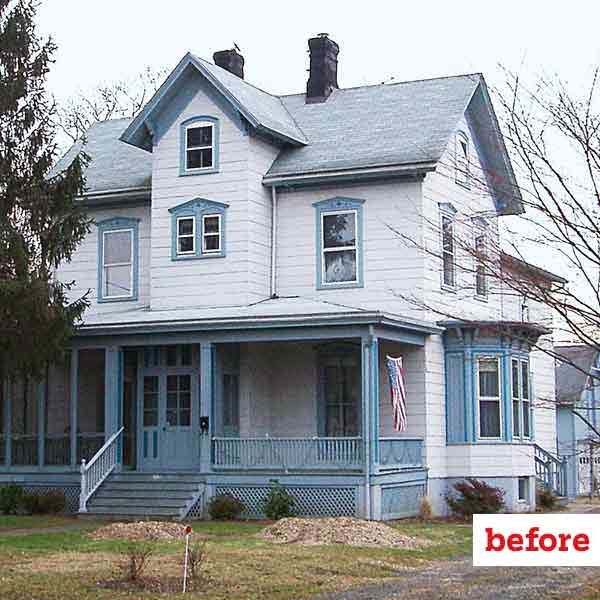
The house was nearly invisible, hidden behind a wall of towering Norway spruce trees. But when Mark Andrew saw it, he knew he’d found the home he had been looking for. “The improvements the house needed were pretty simple,” Mark says of the circa 1890 Folk Victorian, in South Plainfield, New Jersey. A fresh paint job and some overall streamlining—starting with the removal of two of those spruces—made for a dramatic transformation.
Landscaping: Aside from the overwhelming trees, the property had little in the way of plantings. During his first autumn at the house, Mark took advantage of end-of-season sales at his local nursery and created beds along the front and side yards, filled with rhododendron, azalea, barberry, juniper, and maiden grass. He also hired crews to cover the driveway with a fresh layer of crushed stone and to replace 180 feet of deteriorated concrete walkway, making it slightly wider.
Porch: To give the porch a cleaner look, Mark removed the screen panels that enclosed the left side and took out a space-eating vestibule that had been tacked on by a previous owner. Now the original glass-paneled front door, with its elegant scrolled surround, is once again the centerpiece of the facade.
Spiff Up The Existing Structure: After
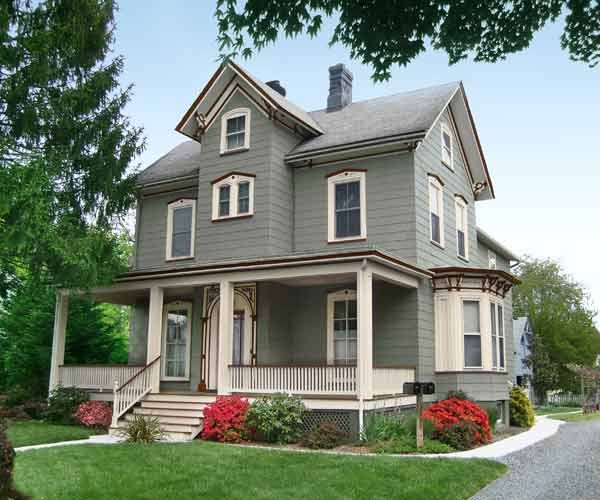
To make a house look grounded, paint the foundation a shade darker than the siding.
Paint: Instead of stripping the asbestos siding that covered the original wood clapboards—a move that would have cost Mark a valuable layer of insulation—he decided to simply paint what was there in Benjamin Moore‘s Antique Pewter. To make the trim details pop, he chose the high-contrast combo of White Mountains and Townsend Harbor Brown.
Windows: The windows on the first floor are well-preserved originals, but upstairs were drafty 1960s-era replacements. Mark swapped out 12 of those for fiberglass double-hungs with period-appropriate two-over-two grille patterns. He went with partial replacement units so that he wouldn’t have to remove moldings and risk damaging the 19th-century woodwork, the walls, and the siding. But fitting new windows into the old framework was no easy task. “None of my sills are level, so I had to make custom trim pieces to fill in the gaps,” says Mark. “Each window took about 10 hours!”
Restore Former Glory: Before
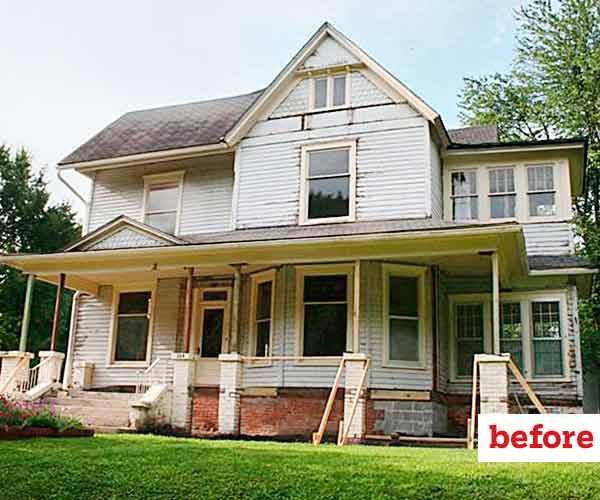
For more than 40 years, Claudia Peterson kept an eye on the vacant 1874 Queen Anne in her hometown of Marshall, Missouri, and wondered about its fate as she watched the once elegant house slowly disintegrate. When the house went up for auction, in May 2010, Claudia and her husband, Russ Rhodes, took control of its destiny. Their plan: Bring back the period details and add some fresh flourishes, including new stained-glass windows and a stately turret.
Siding and trim: Inspired by a historic photo that was given to them at the auction, Claudia and Russ knew that underneath the wide asbestos shingles lay the original 4-inch-reveal cedar siding, along with fish-scale shingles, vertical tongue-and-groove details, and belly band at the gable bases. They hired a crew to remove and properly dispose of the asbestos shingles, and then Russ, a former builder, repaired and replaced damaged portions of the 140-year-old woodwork, including the belly band. To dress up the gable peaks, Claudia ordered stock scrollwork decorations online, saving a bundle over having the embellishments custom-made.
Porch: The pair worked with a mason to re-create the look of the original porch. They also restored a second-story balcony that had been removed, incorporating old posts, a gallery rail, and fan brackets that they sourced locally and online. Spindles saved from the old porch were integrated into the main balustrade.
Restore Former Glory: After
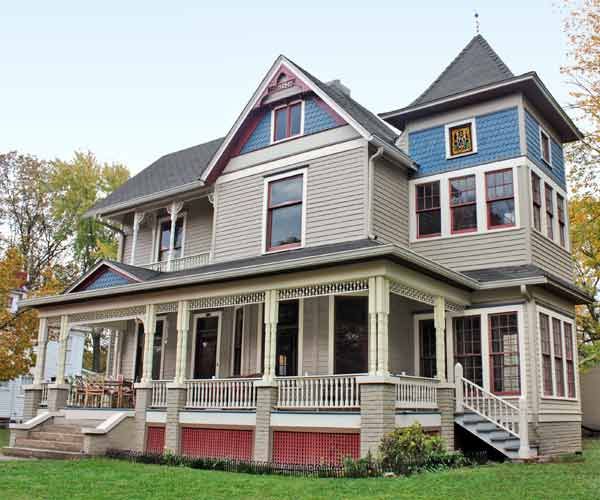
Paint: The couple borrowed the six-color scheme from the original stained-glass transom in the bay window, selecting Sherwin-Williams‘s Prairie Grass for the body, Smoky Blue for the fish scales, and Toile Red for the door, windows, gable decorations, and porch skirting. Creme covers the posts, balustrades, fretwork, and most of the trim. Exceptions are the central gable’s tongue-and-groove details, in Naturel, and the belly band trim, in Tiki Hut.
Windows and door: The single-pane windows are originals, and the multipane ones date to 1905, when two sun porches were added. Claudia and Russ scraped, caulked, and refinished the woodwork. The glass-paneled front door is original too, but a clunky vestibule that had surrounded it was not, so the couple removed it early in the renovation.
Turret: To replace a rotted roof above the sun porches, Claudia and Russ splurged on a turret, a hallmark of the Queen Anne style. Reproduction stained-glass windows, framed and insulated with plexiglass, elevate the grandeur.
